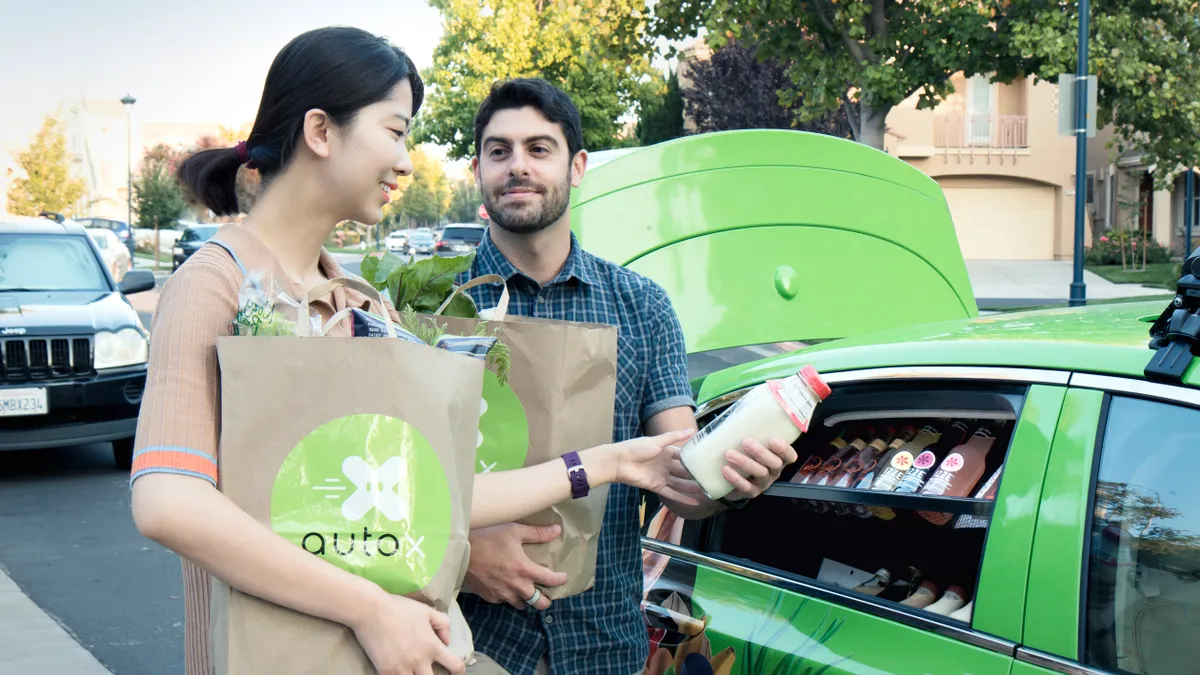Dive Brief:
- Silicon Valley startup AutoX has launched its self-driving grocery delivery service in San Jose, California, according to a company release. The service will allow consumers to pre-order groceries from its app or hail the car to the consumer's location and choose groceries directly from the vehicle.
- The company plans on expanding to other cities around the Silicon Valley area and hopes to eventually partner with other grocers. The products currently come from online grocer GrubMarket.
- The vehicle will include a temperature-controlled environment to keep produce fresh and store yogurt, juices and other snacks for consumers to purchase in-person — giving consumers a similar experience to picking last-minute items from the checkout lane.
Dive Insight:
Since Kroger announced it would begin testing an autonomous grocery delivery service through Nuro in June, a string of competing retailers and startups have launched versions of their own. AutoX joins a growing roster of companies entering this space, including Robomart, which plans to pilot its driverless technology this fall, and Walmart, which recently partnered with Waymo.
If AutoX finds a traditional grocer to partner with, the competition, especially on the West Coast, will heat up to see if companies are able to not only keep pace with Kroger but edge out its self-driving delivery vehicle. Kroger has launched in Scottsdale, Arizona. Walmart is looking at Pheonix. Robomart is eyeing California, and if Amazon ever releases its service, there's a good chance it will be near its headquarters in Seattle.
Investing in this kind of technology is by no means cheap, but could eventually help grocers improve fulfillment and delivery efficiency and cut down on labor costs — also known as "last mile" costs. Eighty percent of delivery costs are associated with labor expenses and wages. The service also allows grocers to reach convenience-seeking customers and those who might not be able to get to the grocery store.
Growing consumer familiarity with online grocery could give initiatives like AutoX a foothold. According to a 2018 study by FMI and Nielsen, almost 70% of American consumers will buy their groceries online in the next five to seven years. This statistic includes services like Instacart, Amazon, and click-and-collect, and makes clear that consumers want more grocery e-commerce and delivery options. This is especially true for younger shoppers who are coming into their spending power and are interested in convenient, fresh and healthy food options.
And while AutoX is similar to competing driverless delivery programs in many ways, it offers a unique value-add that could vault it above its rivals. Many shoppers are hesitant to use services that have third-party grocery pickers select their products — especially fresh foods — an obstacle AutoX avoids by giving consumers the option of picking groceries themselves from the car's selection.
Another obstacle for these budding initiatives is consumer concern over the safety of autonomous driving vehicles. This is of special concern for Walmart, whose self-driving car pilot will pick customers up from their homes and drive them to the store to collect their groceries. However, this number has dropped significantly from 2017 to 2018. Less than half of U.S. consumers hold this view today, while 74% did in 2017, according to Deloitte. “Overall acceptance of autonomous technology has grown rapidly in just a short time,” Craig Griffi, vice chairman at Deloitte and U.S. automotive leader, said in a press release. “However, driverless cars are still in an experimental stage, and the industry is at the front-end of a long capital investment cycle required to bring autonomous vehicle technology to the mainstream market."
It's clear that driverless vehicles could be a powerful differentiator in the future of grocery. It will be interesting to see what creative value-adds new programs will sport to stand out from the crowd, and how long it will take for this technology to go from cutting-edge innovation to mainstream expectation.













